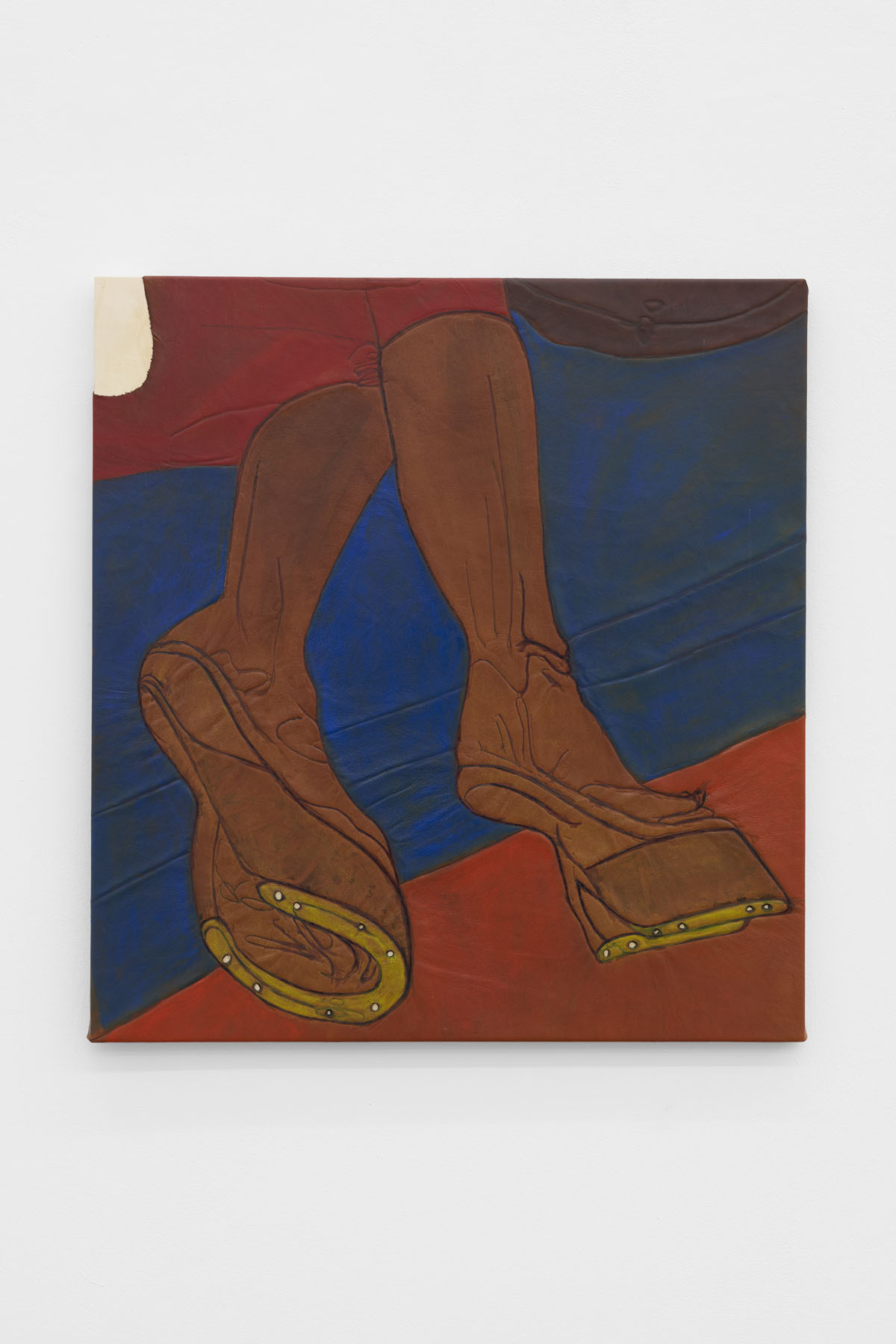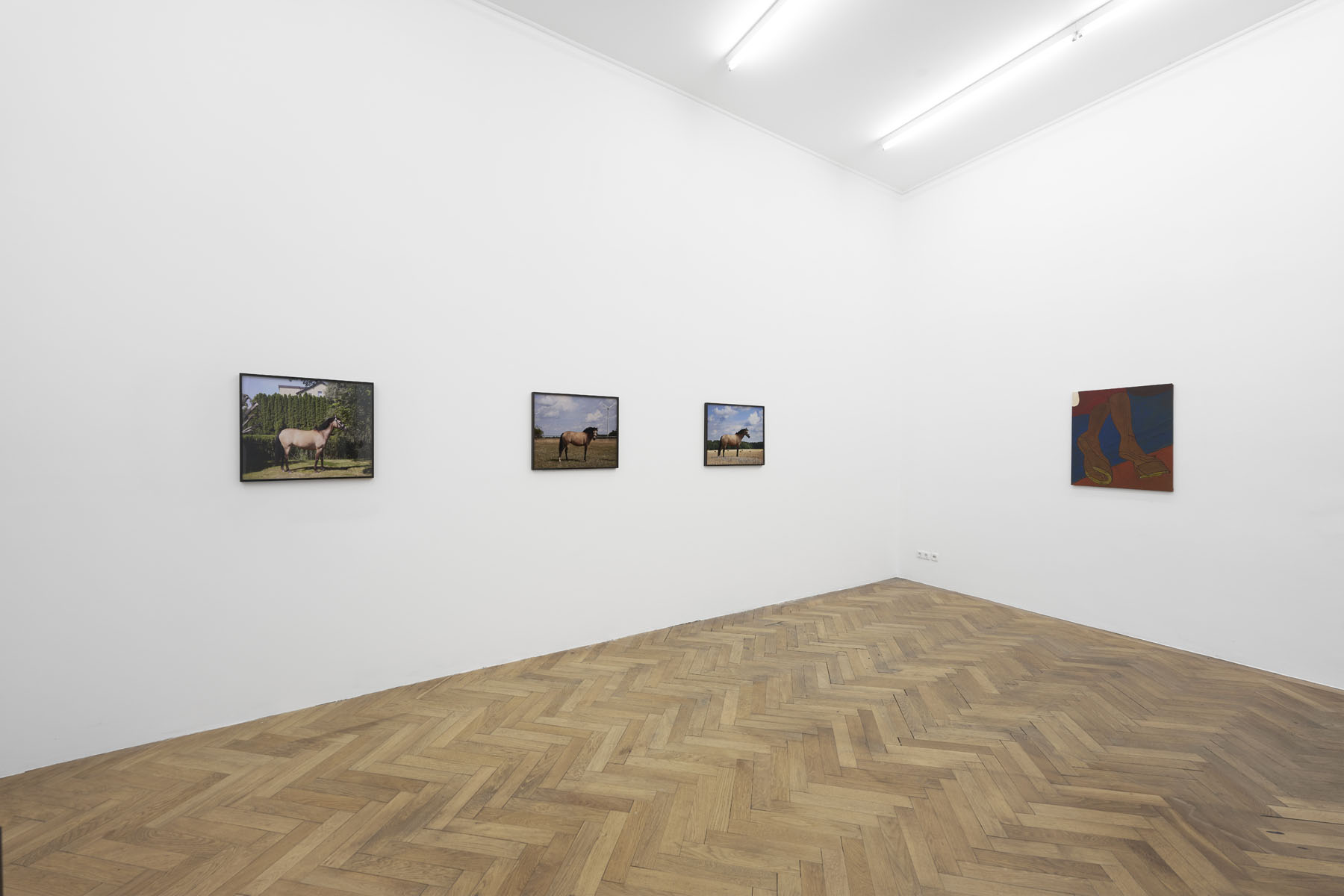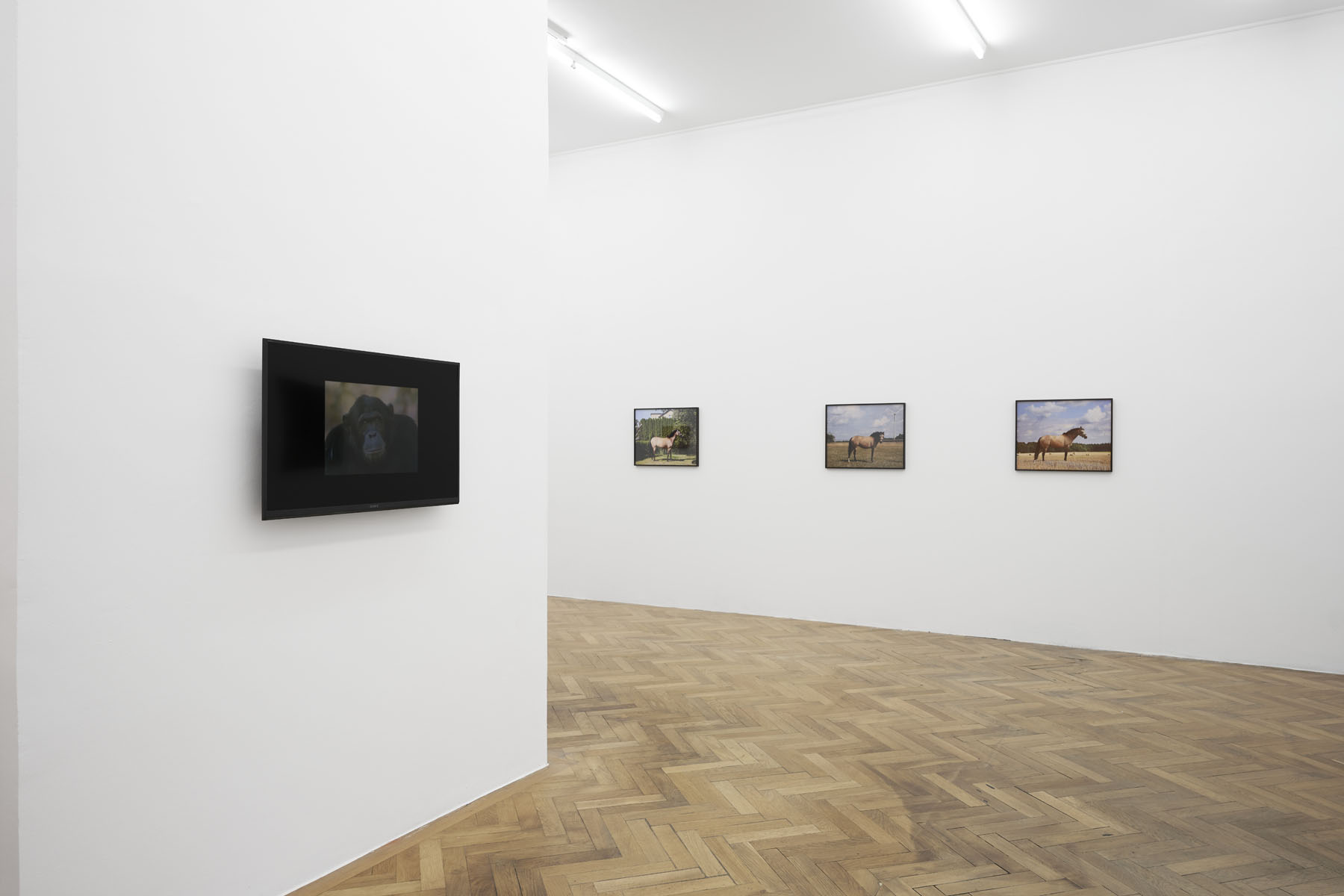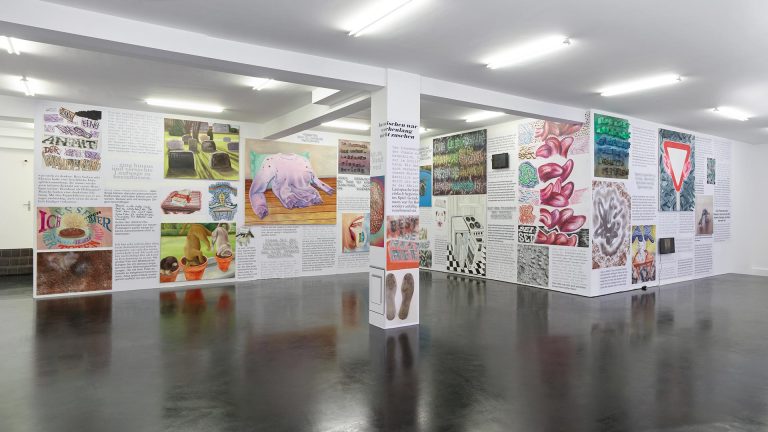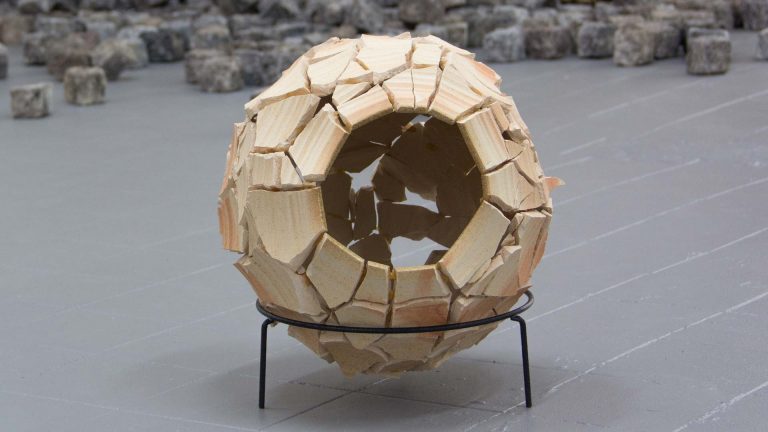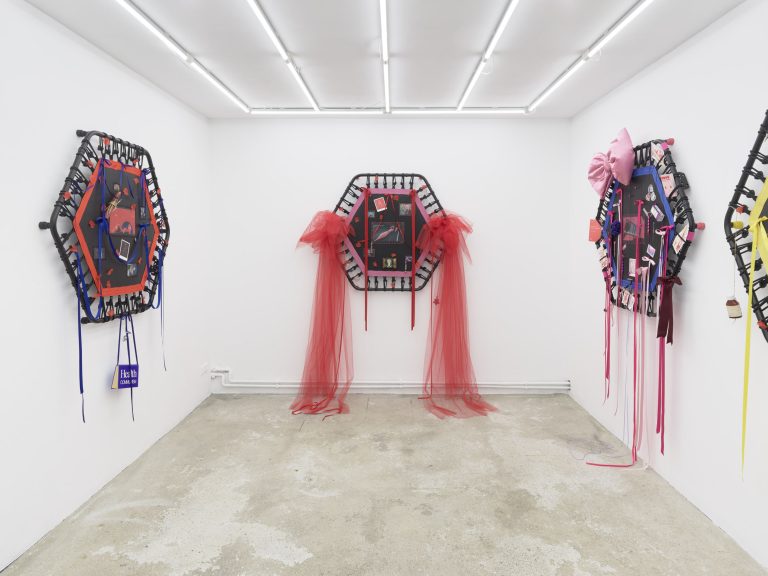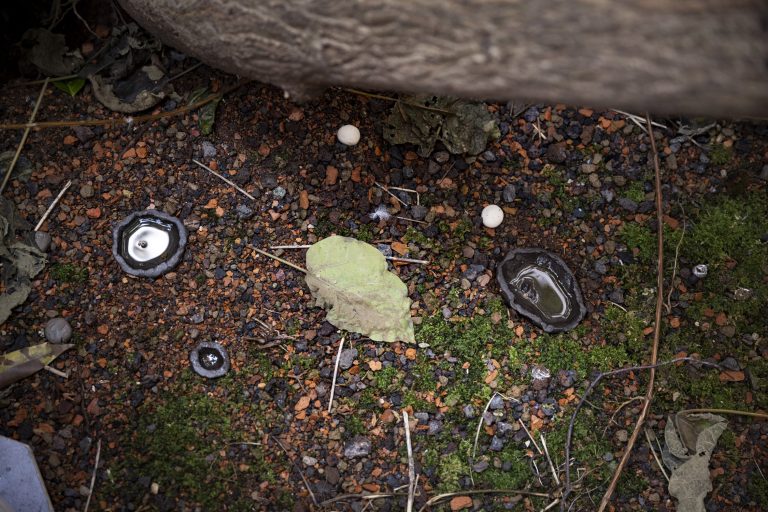Artists: Lena Henke, Dominique Knowles, Megan Francis Sullivan
Exhibition title: Various Others (LAYR hosted by SPERLING)
Venue: SPERLING, Munich, Germany
Date: September 12 – October 17, 2020
Photography: ©the artists. Courtesy of SPERLING, Munich. Photos by Sebastian Kissel
All the works on view here have one thing in common: horses. That is not a new motif in-art—depictions of horses exist in art history on all continents. They are among the earliest pictorial subjects, predating academic art history and reaching back to the deep history of humanity and its artistic impulse, appearing in some of the oldest cave paintings in Lascaux, France, which are approximately seventeen thousand years old.
Horses appear in every epoch and every artistic movement. Since their domestication and systematic use as working animals, they have mostly been shown together with humans: in equestrian portraits, scenes of battle, or harnessed to a quadriga. From the eighteenth century on, the workhorse was an important feature of depictions of rural life, while, at the other end of the social spectrum, the noble steed, as an emblem of successful breeding, functioned as a status symbol for the bourgeoisie. In the modern age, with the technical advances of the twentieth century, motorized vehicles gradually replaced the horse—in agriculture, as means of transport, and as companions in battle—and thereby “fell out of a history to which it had been indispensable for thousands of years,” as Ulrich Rauff writes in his 2015 book Das letzte Jahrhundert der Pferde (The Last Century of the Horse). Rauff describes the “split” or “divorce” of people and horses—but this shift did not take place in art. There was, however, a change in the horse’s role, for example in Jannis Kounellis’s 1969 Senza Titulo (Dodici cavalli) (Untitled [Twelve Horses]). He arranged the horses in the white, rectangular (pictorial) space of the Galleria L’Attico in Rome as if presenting them on a canvas, but at the same time he broke with all the conventions of equestrian painting in that, with the horses’ help, he created a kind of performative readymade. But after their cultural separation from humans, what can horses represent in artworks except “happy pensioners,” as Peter Sloterdijk has described them?
Megan Francis Sullivan asked an animal photographer to take pictures of her own pony, Marie, in the style of the classical horse portraits of the British painter George Stubbs. The photo-graphs show Marie’s muscular body and her proud bearing, but are actually about a shift in medium and historical context. By making use of the infrastructure of contemporary equestrian sports culture (professional horse photography, pony breeding) and indicating the presence of farmed fields, wind turbines, and the pitched rooves of German terraced houses, she transforms Stubbs’s orderly paintings of the living status symbols of the eighteenth century into evidence of the current relationship between nature, culture, and class.
Dominique Knowles is also the owner of a horse, which goes by the name of Tazz. Their close connection to one another reflects Knowles’s understanding of the equal standing and profound companionship of humans and animals. His paintings bring to mind the prehistoric cultural practice of cave painting and testify to the veneration in which humans have held the natural world. His video work Tahlequah, 2019, is a tribute to the capacity of animals to mourn and show empathy, among them the orca Tahlequah, who carried her stillborn calf around with her for seventeen days, or the chimpanzee Flint, who died out of grief for his dead mother.
No horses as such appear in Lena Henke’s works; in their stead are parts and accessories such as hooves, saddles, riding boots, or a tail: they create hybrids of horse and human, city and stable. With a soldering iron Henke has burned the contours of her images irreversibly into tautly stretched leather and thus created a material point of no return akin to that of her model of Manhattan cast in bronze, City Lights (Dead Horse Bay), 2016. In the center of New York, shrunk to a fraction of its actual size, connections to the artist’s life appear alongside references to the aggressive city planning of the twentieth century. In the leather works, meanwhile, imagery from “pony play” pornography coexists with vulvas and phallic-seeming skyscrapers. In Henke’s work, the horse is a fetish object, and makes manifest multi-layered fantasies of domination and submission.
Text: Pia-Marie Remmers
Various Others 2020, Lena Henke, Dominique Knowles, Megan Francis Sullivan in cooperation with SPERLING Munich, 2020, Installation View, SPERLING Munich
Various Others 2020, Lena Henke, Dominique Knowles, Megan Francis Sullivan in cooperation with SPERLING Munich, 2020, Installation View, SPERLING Munich
Various Others 2020, Lena Henke, Dominique Knowles, Megan Francis Sullivan in cooperation with SPERLING Munich, 2020, Installation View, SPERLING Munich
Various Others 2020, Lena Henke, Dominique Knowles, Megan Francis Sullivan in cooperation with SPERLING Munich, 2020, Installation View, SPERLING Munich
Various Others 2020, Lena Henke, Dominique Knowles, Megan Francis Sullivan in cooperation with SPERLING Munich, 2020, Installation View, SPERLING Munich
Various Others 2020, Lena Henke, Dominique Knowles, Megan Francis Sullivan in cooperation with SPERLING Munich, 2020, Installation View, SPERLING Munich
Various Others 2020, Lena Henke, Dominique Knowles, Megan Francis Sullivan in cooperation with SPERLING Munich, 2020, Installation View, SPERLING Munich
Various Others 2020, Lena Henke, Dominique Knowles, Megan Francis Sullivan in cooperation with SPERLING Munich, 2020, Installation View, SPERLING Munich
Various Others 2020, Lena Henke, Dominique Knowles, Megan Francis Sullivan in cooperation with SPERLING Munich, 2020, Installation View, SPERLING Munich
Various Others 2020, Lena Henke, Dominique Knowles, Megan Francis Sullivan in cooperation with SPERLING Munich, 2020, Installation View, SPERLING Munich
Various Others 2020, Lena Henke, Dominique Knowles, Megan Francis Sullivan in cooperation with SPERLING Munich, 2020, Installation View, SPERLING Munich
Various Others 2020, Lena Henke, Dominique Knowles, Megan Francis Sullivan in cooperation with SPERLING Munich, 2020, Installation View, SPERLING Munich
Lena Henke, City Lights (Dead Horse Bay), 2016, bronze, painted wood, 105 x 125 x 65 cm (mit Sockel), 23 x 125 x 65 cm (ohne Sockel)
Various Others 2020, Lena Henke, Dominique Knowles, Megan Francis Sullivan in cooperation with SPERLING Munich, 2020, Installation View, SPERLING Munich
Lena Henke, City Lights (Dead Horse Bay), 2016, bronze, painted wood, 105 x 125 x 65 cm (mit Sockel), 23 x 125 x 65 cm (ohne Sockel)
Lena Henke, City Lights (Dead Horse Bay), 2016, bronze, painted wood, 105 x 125 x 65 cm (mit Sockel), 23 x 125 x 65 cm (ohne Sockel)
Lena Henke, Niche, 2020, Soldered, burned and painted leather on wood, 70 x 75 cm
Dominique Knowles, The Solemn & Dignified Burial Befitting My Beloved for All Seasons, 2020, Oil on panel, 30.48 x 45.72 cm
Lena Henke, City Lights (Dead Horse Bay), 2016, bronze, painted wood, 105 x 125 x 65 cm (mit Sockel), 23 x 125 x 65 cm (ohne Sockel)
Lena Henke, City Lights (Dead Horse Bay), 2016, bronze, painted wood, 105 x 125 x 65 cm (mit Sockel), 23 x 125 x 65 cm (ohne Sockel)
Megan Francis Sullivan, Marie 148, 2014, von Miraculix, aus Moonlight Besitzer: Megan Sullivan, Helmut Draxler Fotograf: Renke Klaproth #3, 2020, Classic Art Print, 50 x 62,5 cm
Megan Francis Sullivan, Marie 148, 2014, von Miraculix, aus Moonlight Besitzer: Megan Sullivan, Helmut Draxler Fotograf: Renke Klaproth #2, 2020, Classic Art Print, 50 x 62,5 cm
Megan Francis Sullivan, Marie 148, 2014, von Miraculix, aus Moonlight Besitzer: Megan Sullivan, Helmut Draxler Fotograf: Renke Klaproth #1, 2020, Classic Art Print, 50 x 62,5 cm
Dominique Knowles, Tahlequah (Act III) (Tribute to the orca Tahlequah, the chimpanzee Flint and other empathic animal beings in mourning), 2019, Video, 12:07min, Edition of 5 + 2 AP (Excerpt)
Dominique Knowles, Tahlequah (Act III) (Tribute to the orca Tahlequah, the chimpanzee Flint and other empathic animal beings in mourning), 2019, Video, 12:07min, Edition of 5 + 2 AP (still)
Dominique Knowles, Tahlequah (Act III) (Tribute to the orca Tahlequah, the chimpanzee Flint and other empathic animal beings in mourning), 2019, Video, 12:07min, Edition of 5 + 2 AP (still)
Dominique Knowles, Tahlequah (Act III) (Tribute to the orca Tahlequah, the chimpanzee Flint and other empathic animal beings in mourning), 2019, Video, 12:07min, Edition of 5 + 2 AP (still)

